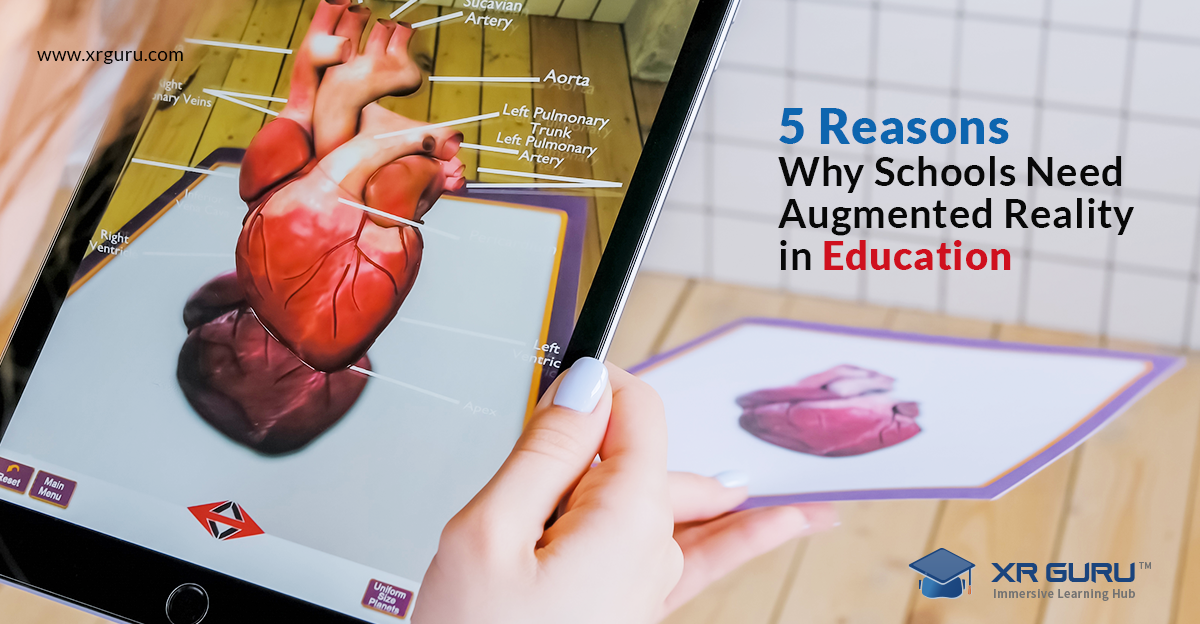5 Reasons Why Schools Need Augmented Reality in Education

Amid the COVID-19 pandemic, tech-based learning has turned heads, and more educators have started to migrate from traditional learning methods. Augmented reality is a leading EdTech trend, and according to ABI Research, the value of AR for education is estimated to reach US$5.3 billion by 2023.
In this article, we give five reasons that highlight how AR can transform school education.
1. Potential of Visualized Learning
When it comes to education, the power of visual content cannot be downplayed. AR-based education uses 3D-image models and digital projections, which help students understand complex concepts with relative ease. For example, instead of looking at an image in a textbook, students can see a 3D projection of a chemical compound and visualize the structure of atoms to understand abstract concepts.
Students who learn through visual models understand the subject matter quicker and have better retention rates. In fact, a study shows that ability to recall written or spoken information after three days was to 20 percent, whereas the retention rate was 65 percent for visual information.
2. Interactive Learning Environment
Incorporating AR in education makes learning more fun, interactive, and engaging. Teachers can team up with students and participate in activities to make the lessons more appealing. Teachers can jazz up boring lectures by creating interactive 3D simulations where the students work together. It spurs students' imagination to learn new things in a fun and interactive way, and it also enables students to make a deep connection with the subject matter.
3. Heightened Student Engagement
The attention span of Gen-Z kids is dwindling, and keeping the learners engaged throughout the lesson is one of the challenges in traditional education. For instance, try engaging with students in a history class after lunch when they are in a sleepy state.
However, interactive, gamified AR educational content can hold the attention of students for the entire lesson. Each class can be a different adventure in the AR world; this instills curiosity among students and motivates them to participate actively in every lecture.
4. Hands-on Learning Approach
"I hear, and I forget; I see, and I remember; I do, and I understand."
This old Chinese proverb highlights the importance of active learning and adopting AR in education offers exactly that: a hands-on, practical learning approach.
Amid the pandemic, digitized education has swapped places with conventional learning methods. The lack of practical elements is a downside of online education. But using AR technology can offer a solution to this problem as it has the potential to bridge the gap between digital and real-life education.
Augmented reality also facilitates safe training environments where students can practice and explore new techniques without brooding about the risk factor.
5. Cost-effective
Some educators cite the price factor as a roadblock in adopting AR technology in education. However, as the number of smart devices continues to increase (and meet the hardware requirements to run AR apps), it is safe to say that investing in augmented reality education is economical.
Further, AR has the potential to transform study material and replace textbooks and printed learning resources, thereby eliminating the expenses on study materials such as textbooks.
Concluding Thoughts
The above reasons are just a sliver of the full scope to incorporate AR learning in your schools. With more institutions focusing on the digitalization of education, there has never been a better time to invest in augmented reality education.
"Imagination will often carry us to worlds that never were. But without it, we go nowhere."
- Carl Sagan.
The younger generation is intrigued by newer technology, so if you want to spark their imagination to build a better future, AR is the best way forward.
Curious about utilizing AR in education? XR Guru is the next-gen application to enhance your student's learning experience. With XR Guru, you can customize your lessons and provide a hands-on learning environment that makes it easy for your students to grasp complex subjects.
Get in touch with us for a free consultation on your augmented reality educational needs
Claim Your Free Consultation



Comments
Post a Comment